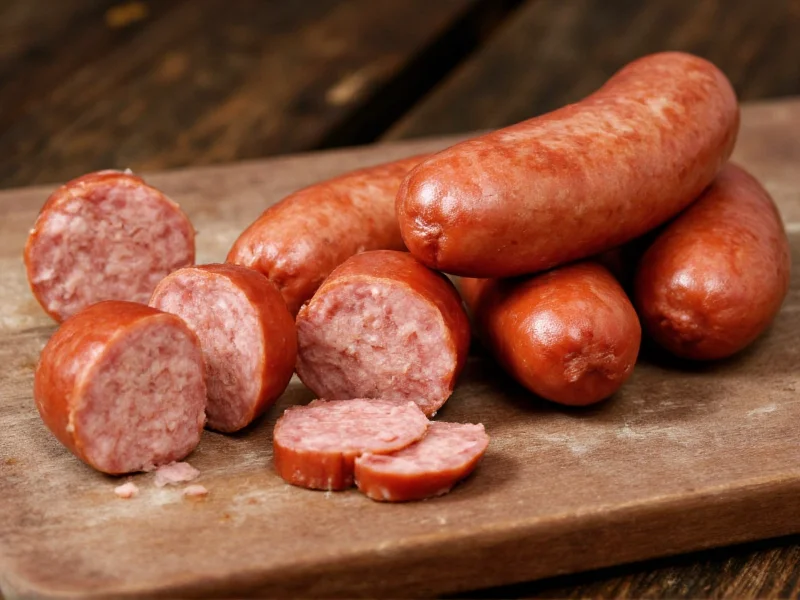Many people confuse butter sausage with regular sausage varieties or mistakenly believe it contains actual chunks of butter. The "butter" in butter sausage refers to its smooth, buttery texture rather than literal butter chunks. This specialty sausage originated in southern Germany and Austria where butchers developed recipes that incorporated dairy elements to create a uniquely tender product.
Historical Origins of Butter Sausage
The tradition of butter sausage dates back to 19th century Bavaria and Tyrol regions. Local butchers discovered that adding small amounts of butterfat to finely ground meat mixtures created a remarkably smooth texture that distinguished their products from standard bratwurst or knackwurst. Historical records from Austrian culinary archives show that "Butterwurst" first appeared in butcher shop ledgers around 1847. Unlike blood sausages or smoked varieties, butter sausage represented a premium product for special occasions due to the relative expense of butter at that time.
Butter Sausage vs Regular Sausage: Key Differences
Understanding the distinction between butter sausage and conventional sausage varieties helps clarify this specialty product:
| Characteristic | Butter Sausage | Regular Sausage |
|---|---|---|
| Fat Content | 25-30% (includes butterfat) | 15-20% (primarily meat fat) |
| Texture | Exceptionally smooth, almost creamy | Grainier, more noticeable meat particles |
| Preparation Method | Finely emulsified, gently poached | Coarsely ground, often smoked or grilled |
| Flavor Profile | Milder, richer, buttery notes | Stronger meat flavor, more pronounced spices |
| Storage Life | Shorter (3-5 days refrigerated) | Longer (up to 2 weeks refrigerated) |
Authentic Preparation Methods
Crafting genuine butter sausage requires specific techniques that home cooks often overlook when attempting authentic butter sausage recipe variations. Professional butchers begin with premium cuts of pork shoulder and belly, maintaining a precise 70:30 lean-to-fat ratio. They then incorporate cold butter pieces (never melted) into the meat mixture during the final grinding stage at temperatures below 40°F (4°C). This critical step prevents the butter from separating during cooking.
The emulsification process demands careful attention—modern sausage makers use vacuum tumblers to incorporate air while traditional methods involve hand-chopping on marble slabs. After casing, butter sausage requires gentle poaching in water maintained between 160-170°F (71-77°C), never boiling, to preserve its delicate structure. Many enthusiasts searching for how to cook butter sausage make the mistake of treating it like standard bratwurst, resulting in broken casings and separated fats.
Cultural Significance Across Regions
Butter sausage holds particular cultural importance in specific regions:
- Bavaria, Germany: Served as "Butterwurst" during Oktoberfest's quieter morning hours, traditionally with sweet mustard and pretzels
- Tyrol, Austria: Featured in "Wurstsalat" (sausage salad) with vinegar-based dressing, a common post-hike meal
- Alpine regions: Incorporated into "Wurstknödel" (sausage dumplings) served in clear broth
- Midwestern United States: Adapted by German immigrants as "butter ball sausage," often grilled at summer gatherings
Contrary to popular belief outside German-speaking countries, authentic butter sausage never contains actual butter chunks. The name refers to its smooth, buttery mouthfeel achieved through precise emulsification techniques. This misunderstanding often leads people searching for what is butter sausage to expect visible butter pieces, which would indicate a poorly made product.
Nutritional Profile and Dietary Considerations
When examining butter sausage nutritional facts, several important considerations emerge. A standard 3-ounce serving contains approximately 280-320 calories, with 25-28 grams of fat (10-12 grams saturated). The inclusion of butterfat increases the monounsaturated fat content compared to standard sausages, potentially offering modest cardiovascular benefits when consumed in moderation.
Dietary restrictions require special attention—traditional butter sausage contains dairy, making it unsuitable for strict lactose-intolerant individuals or kosher diets. Some modern producers create dairy-free versions using specialized fat blends, though purists argue these miss the essential character of genuine butter sausage. For those monitoring sodium intake, butter sausage typically contains 500-700mg per serving, slightly less than many smoked sausage varieties due to its fresh preparation method.
Serving Traditions and Pairing Suggestions
Authentic butter sausage deserves specific serving approaches that enhance its delicate flavor. Germans traditionally serve it slightly warm rather than hot, allowing the buttery notes to shine. Common regional preparations include:
- Butterwurst am Stiel: Skewered with a wooden stick, lightly grilled, and served with sweet Bavarian mustard
- Wurstsalat: Sliced thin and marinated in vinegar, oil, and onions—a Swabian specialty
- Butterwurstsuppe: Cubed and added to clear broth with fresh herbs for an elegant starter
When considering how to serve butter sausage, avoid overpowering its subtle flavor with strong condiments. Traditional pairings include mild sweet mustards, fresh horseradish cream, or simply salt and white pepper. Beverage pairings work best with light-bodied beers like Helles lagers or dry German white wines that won't overwhelm the delicate sausage flavors.
Finding Authentic Butter Sausage
Locating genuine butter sausage presents challenges outside its regions of origin. When searching for where to buy butter sausage, look for these indicators of authenticity:
- Butcher shops specializing in German or Austrian products
- Products labeled "Butterwurst" rather than "butter sausage"
- Ingredients listing butter or butterfat (not just "natural flavors")
- Refrigerated (not shelf-stable) packaging
- Short ingredient lists without fillers or artificial preservatives
Major supermarket chains rarely carry authentic versions, though some specialty food retailers offer imported German Butterwurst. Online specialty meat purveyors provide the most reliable source for those outside traditional sausage-making regions, though shipping costs and freshness concerns require careful consideration.











 浙公网安备
33010002000092号
浙公网安备
33010002000092号 浙B2-20120091-4
浙B2-20120091-4